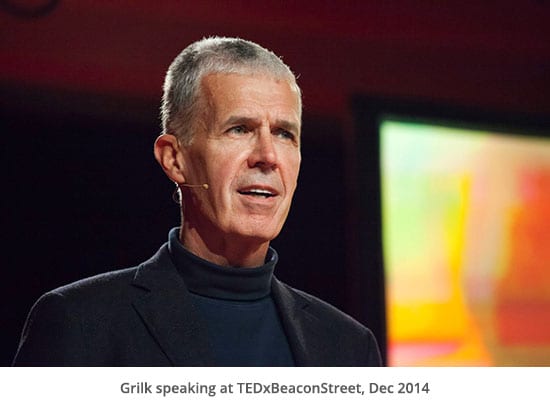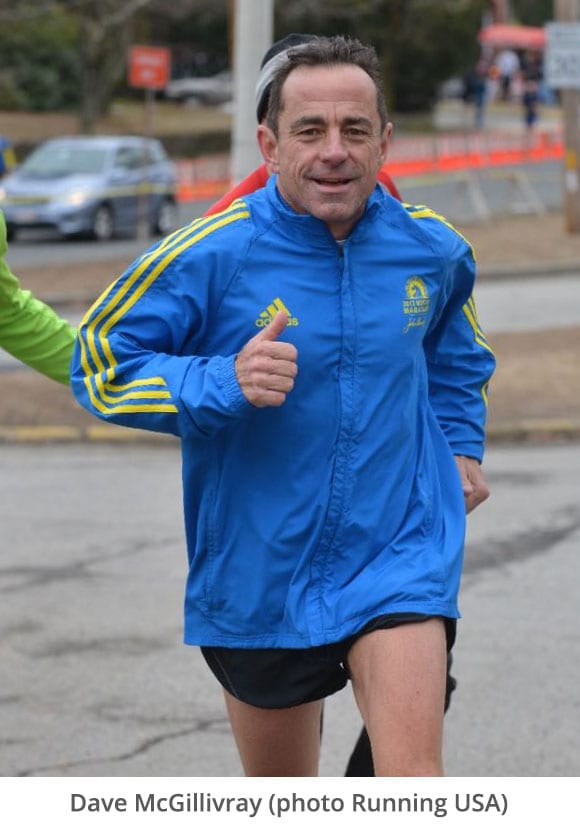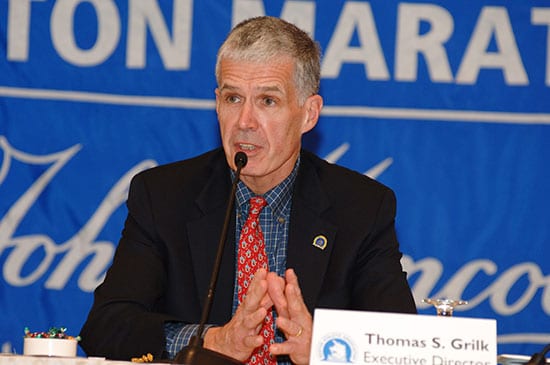Catching up with Tom Grilk: the RaceRaves interview

Occupation: Executive Director, Boston Athletic Association
Hometown: Lynnfield, MA
Notable: “In Boston, everyone owns the marathon” — no one understands this sentiment better than the man who voiced it, Tom Grilk. Grilk is the Executive Director of the Boston Athletic Association (B.A.A.), the non-profit organization that has managed the Boston Marathon since the race’s inception in 1897. A Massachusetts native and one-time member of the legendary Greater Boston Track Club, Grilk joined the B.A.A. as a regular member in 1987 and rose through the ranks to become Executive Director in 2011. His steady leadership was instrumental in ensuring the race — and the communities that support it — rebounded from the horrific marathon bombings of 2013, embracing the rallying cry of “Boston Strong”. As if overseeing all details of Marathon Monday weren’t enough, Grilk has also served as the event’s finish line announcer since 1979, a torch he recently passed to CBS Boston sports anchor Dan Roche and 1983 marathon champion Greg Meyer.
With Patriots Day and the 120th Boston Marathon fast approaching, we caught up with Grilk to get his unique perspective on the B.A.A.’s flagship event. His thoughtful answers offer a compelling glimpse into the behind-the-scenes choreography of the world’s most prestigious marathon.
What are your responsibilities at the B.A.A. and specifically on Marathon Monday?
I have overall responsibility for the day-to-day operation of the organization, and on Marathon Monday, responsibility for the events of the day. What that means in practice is that I am responsible to do all that one can to enable the magnificent work done by our staff every day of the year, together with the work done by the thousands of others who engage with us as sponsors, contractors, volunteers and members of the public who support our events and those who participate in them.
What is your biggest challenge during Boston Marathon weekend?
Assuring that everyone who works in support of the athletes has the resources and help that they need to display the commitment, imagination and discipline that they bring together every year, for it is that dedication and the spirit of the runners and spectators that brings magic to the Boston course each year.
What percentage of Boston Marathon participants run as qualifiers vs. running with the B.A.A. Official Charity Program?
In excess of 80% of the field meets the qualifying standards. The great majority of the balance of the field represent charities and the various municipalities, agencies and others who provide the support necessary for the race to be conducted.

Each September, with the opening of registration, conversations inevitably turn to Boston’s qualifying standards. As the number of qualified runners vying for a limited number of spots has surged in recent years, the B.A.A. has had to impose secondary cutoff times to maintain a manageable field size. Has the B.A.A. considered a) further tightening its qualifying standards to better set expectations among runners, or b) reducing the percentage of charity participants, to make room for more qualifiers?
We regularly review whether change is warranted to the qualifying standards. It is important to understand that any change to those standards requires a great deal of lead time, since the qualifying window for any one race opens some 18 months before the event. As for reducing the number of charity runners, we have no plans to do that. We do the best we can to establish the right balance among the various categories of participants. The participation of charity athletes is one way for us to support the communities that so strongly support the race. But with all of that said, we are keenly aware of the disappointment felt by a runner who meets the qualifying standard and still does not get a spot in the field. Many of us, me included, have worked very hard to meet those standards — sometimes succeeding and sometimes not — and we have deep respect for everyone who undertakes that challenge.
How is the field size set each year? The Centennial event of 1996 (~38,000 runners) and the Boston Strong comeback of 2014 (~36,000 runners) hosted atypically large fields. Are those field sizes simply not sustainable?
The field size is set in discussion with each of the eight cities and towns through which the race passes. It is governed largely by the size of the roads — they remain just about as narrow as they were when the race began in 1897 — and by the need of the cities and towns along the way to reopen their streets to residents. The fields in 1996 and 2014 were established due to very special circumstances and imposed a considerable burden on the communities through which the race is run.
After the bombings in 2013, how much did the worldwide outpouring of support for “Boston Strong” mean to you and your colleagues?
That support was powerful and it was sustaining through a very challenging and emotional period — not just for us, but for everyone who was so profoundly affected by the events of 2013. It left us with a deep sense of obligation to live up to that support in all that we do.
Speaking of your colleagues, Dave McGillivray is an amazing  guy both professionally and personally. What is it about Dave that makes him the perfect choice for Race Director of the Boston Marathon?
guy both professionally and personally. What is it about Dave that makes him the perfect choice for Race Director of the Boston Marathon?
Planning, patience, persistence, dedication and, above all, judgment. Dave shares with all of us a deep respect for the race, for its traditions, and for all involved with it, and he is a reservoir of knowledge about every element of the race. But it is rapid analysis and judgement that make the difference, both leading up to the race and during the race when problems inevitably present themselves — sometimes exceptionally challenging and unforeseeable problems. Dave displays all of these important qualities, as do all of our senior leaders in the marathon.
The city of Boston seems to breed speedy marathoners, and we know you were once one yourself. What’s your own marathon PR and Boston PR?
Compared to the truly fast runners in Boston I was lost in the dust. My best Boston was 2:54 and my PR was 2:49:03, struggling to qualify for Boston when that qualifying time once dropped to 2:50. In those days many of the fastest runners in Boston were part of the Greater Boston Track Club; my best time only made me the 100th fastest member of that group.

Aside from its qualifying standards, what is it that sets Boston apart from the other World Marathon Majors?
Most important is nearly 120 years of hard work and excellence by countless runners, as well as 120 years of the members of our community treating the race and the runners as their own, bringing to all of that a spirit that has gratified runners for decades. The marathon is part of the fabric of Boston: people who go to watch and help often do so in the footsteps of their parents and their grandparents and sometimes beyond. There is no substitute for history.
In closing, is there anything else you’d like to share with our audience, many of whom list the Boston Marathon as their top bucket-list running goal?
For those who want to run here I hope that they have the opportunity to experience the feeling of running down the last, straight kilometer to the finish amidst the thundering resonance of the urban canyon that is Boylston St. on race day. It is a thrill that is difficult to match for those of us who are citizen athletes, training in the heat and the snow, knowing that we will never be paid for it, but basking in a thrill that we have earned through nothing but our own hard work.
Click HERE to watch Tom’s TEDxBeaconStreet talk, “In Boston, everyone owns the marathon”.
***
Find this article informative or entertaining? Please share it, and sign up for a free RaceRaves account to receive future articles by email. RaceRaves is your premier online resource to DISCOVER, REVIEW & TRACK all your races and to CONNECT with other runners!
Other RaceRaves articles worth checking out:
Toughest road marathons in the U.S. & Canada
The race every runner should run
The “Boston” of Half Marathons
10 alternatives to the NYC Marathon
Alan Nawoj: Fastest across 7 continents
No comments yet